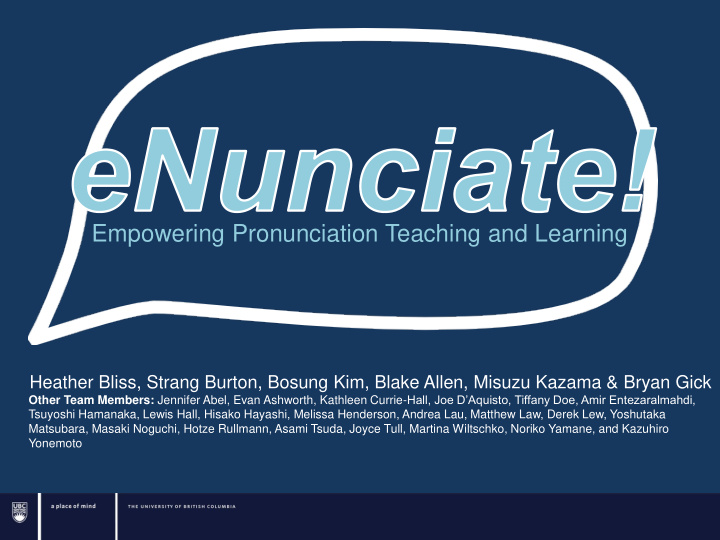



Empowering Pronunciation Teaching and Learning Heather Bliss, Strang Burton, Bosung Kim, Blake Allen, Misuzu Kazama & Bryan Gick Other Team Members: Jennifer Abel, Evan Ashworth, Kathleen Currie- Hall, Joe D’Aquisto, Tiffany Doe, Amir Entezaralmahdi, Tsuyoshi Hamanaka, Lewis Hall, Hisako Hayashi, Melissa Henderson, Andrea Lau, Matthew Law, Derek Lew, Yoshutaka Matsubara, Masaki Noguchi, Hotze Rullmann, Asami Tsuda, Joyce Tull, Martina Wiltschko, Noriko Yamane, and Kazuhiro Yonemoto
The Team Heather He r Bliss St Stra rang ng Burton Twelve-Month Lecturer, Postdoctoral Fellow and Department of Linguistics Sessional Lecturer, Department of Linguistics Bosung ng Kim Blake Allen Instructional Designer, PhD Candidate and Centre for Teaching, Research Assistant, Learning and Technology Department of Linguistics Misuz uzu u Kazama ma Bryan an Gick Japanese Language Professor and Head, Instructor, Department of Department of Linguistics Asian Studies
History of the Project The speech visualization software tools were developed by the project team for the TLEF project “Multimodal approaches to the empowerment of pronunciation teaching and learning: Creating online interactive tutorial videos” (2014, PI: Dr. Bryan Gick) The precursor to this project is “Visible Speech Project” (2013, PI: Kathleen Hall)
Objectives Pronunciation is an integral part of communication, but it has proven to be one of the most challenging aspects to incorporate into language pedagogy and to implement in the classroom Our tools and resources draw on Our project addresses ultrasound and other speech these problems, and visualization technology and its gives learners control and application in articulatory phonetics autonomy over their own learning Evidence-based approach: We evaluate and report on the impact of our resources on teaching and learning; 9 presentations and publications to date, others forthcoming
Have you ever struggled while learning or teaching how to pronounce sounds in a foreign language?
Uses various tools and resources to aid in the learning and teaching of pronunciation such as: Multimodal tool to visualize Interactive and speech autonomous training Biovisual feedback for Ultrasound kit for pronunciation training customized resources
Do you think that allowing students to see the articulatory mechanisms underlying different speech sounds can help with learning pronunciation?
Interactive International Phonetic Alphabet Chart Sounds of the World’s Languages Consonants Alternative Airflow Consonants Vowels
Educational resources enable students to visualize speech sounds of the world’s languages High-quality animations present stylized representations of speech mechanisms Ultrasounds overlay videos combine mid-sagittal images of tongue movements with external profile views of a speakers head
How do you think interactive and autonomous training will benefit students learning a new language?
Japanese Pronunciation Tutorial website offers learners opportunities for self-directed, interactive pronunciation training Learners have control and autonomy over their learning, engaging with site in a way that mimics one-on-one interactions with speakers. Tutorial consists of instructional videos, practice exercises , and quizzes . Content developed based on Japanese instructors’ knowledge of pronunciation challenges and linguists’ understanding of speech production .
Student surveys reported that learners’ understanding and pronunciation of Japanese sounds improved . Future developments include websites for other languages including French, Spanish, German, and Chinese.
Do you find it difficult to implement the essential repetition and feedback for pronunciation training in a classroom setting?
The use of biovisual feedback using visualization technology can improve pronunciation for language learners and other populations. Ultrasound-based tutorials allow learners to get feedback on their pronunciation of challenging sounds Online prosody visualizer allows students to record utterances and compare with model speaker.
Are you interested in customizing these resources for the languages you are teaching or learning?
“Tongue visualizer” software enables language instructors and other users to develop customized ultrasound overlay videos Language teachers will be able to produce custom resources focusing on specific pronunciation challenges in their own languages Particularly useful for the sounds of BC’s First Nations languages Custom videos in development for: Cantonese (final obstruents, vowels) Upriver Halq’emeylem (dorsal sounds) SENĈOŦEN (full alphabet; created by community language apprentices)
ACKNOWLEDGEMENTS We gratefully acknowledge the financial support for this project provided by UBC Vancouver students via the Teaching and Learning Enhancement Fund. Research related to this project is funded by a grant awarded to B. Gick from the UBC Faculty of Arts, and we gratefully acknowledge this support.
REFERENCES Abel, J., B. Allen, S. Burton, M. Kazama, M. Noguchi, A. Tsuda, N. Yamane, B. Gick. 2015. Ultrasound enhanced multimodal approaches to pronunciation teaching and learning. Canadian Acoustics 43: 124-5. Adler-Bock, M., B. Bernhardt, B. Gick, P. Bacsfalvi. 2007. The use of ultrasound in remediation of North American English /r/ in 2 adolescents. American Journal of Speech-Language Pathology 16: 128-139. Bernhardt, B., B. Gick, P. Bacsfalvi, M. Adler-Bock. 2005. Ultrasound in speech therapy with adolescents and adults. Clinical Linguistics and Phonetics 19: 605-17. Gick, B., B. Bernhardt, P. Bacsfalvi, I. Wilson 2008. Ultrasound imaging applications in second language acquisition. In Hansen & Zampini (eds), Phonology and Second Language Acquisition . Benjamins: 309-22. Noguchi, M., N, Yamane, A. Tsuda, M. Kazama, B. Kim, B. Gick. 2015. Towards protocols for L2 pronunciation training using ultrasound imaging. Poster presentation at PSLLT 7. Dallas, TX: October 2015. Tsuda, A., B. Kim, B. Gick, M. Kazama, N. Yamane, S. Burton. 2015. Ultrasound-integrated pronunciation tutorials. Roundtable discussion presented at the Society for Teaching and Learning in Higher Education. Vancouver, BC.
Recommend
More recommend